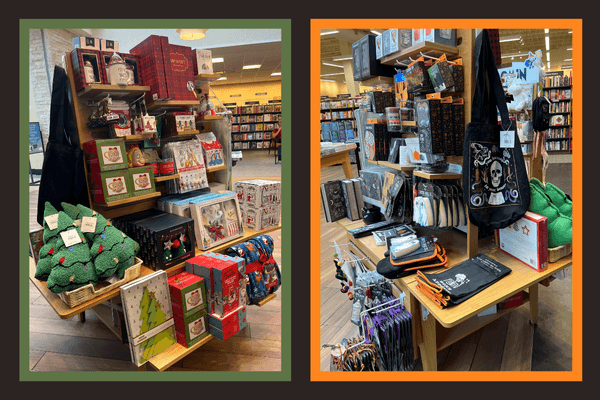Updated October 9, 2025
Why do retailers launch holiday promotions before the jack-o'-lanterns are carved? For the same reason back-to-school sales start mid-summer: savvy shoppers are always planning ahead.There is one basic reason all retailers should do this: wallets.
Most customers have a mental budget for the holidays: decorations, gifts for the family, teachers/coaches, and the office. The sooner those customers spend money earmarked for gift-giving, the less they will spend at the traditional time to buy holiday gifts.
That's why I refer to this time as the Bitch'N Buy season. Customers may complain about seeing Christmas in September, but they still buy it so they won't miss out.
"I can't believe they already have Christmas stuff out, and it's not even Halloween."
Y-A-W-N.
2025 Holiday Retail Sales Forecast: What to Expect
Retail sales are expected to grow 3.5% to 4.0% this holiday season, bringing total spend to over $1.7T, according to ICSC's 2025 holiday shopping forecast. In-store sales will increase between 2.3 and 3.4 percent, while e-commerce sales will grow by 9 percent year-over-year, according to Mastercard.
But with tariffs now in effect, we might see higher dollar sales simply because items cost more—not because customers are buying more units. That means inventory planning matters more than ever.
And that's the opportunity for all merchants to put out the Christmas merchandise now.

Holiday Display Strategies That Work
This isn't new, but smaller retailers have resisted. I suggest they get on board, like Barnes & Noble (pictured above). They used a two-sided display rack with Christmas items on one side and Halloween merchandise on the other.
The photo was taken on September 30. This works because seasonal shoppers typically buy for multiple occasions...capture both sales at once.
Catalogs with holiday items have been arriving at mailboxes since August. They must know something.
I'm not saying holiday items must be in your main display windows or prime selling space. Just as you gradually incorporate holiday music into your store playlist, you can introduce more holiday items throughout November and into December.
With new smartphones expected to take a larger amount out of parents' holiday budgets, what will be left over for any store will be smaller.
Smart merchants look at customer behavior when merchandising their stores and making their holiday preparations, not their own preferences of only seeing merchandise in stores after Thanksgiving.
The Early Bird Reality
Customers who see holiday items early don't just notice them - they start building mental shopping lists. They bookmark websites. They compare prices across stores. They decide who has the best selection.
By the time November arrives, those decisions are already made. If you're not in that early consideration set, you've already lost the sale.
This matters most in specific categories. Home decor shoppers want to see the full range before committing to a theme. They're coordinating wreaths, table settings, and mantel displays—not impulse buying. Specialty gift buyers (food items, unique toys, local goods) need time to discover you exist. These aren't Amazon purchases. They require discovery, and discovery takes time.
The retailers who put merchandise out in October capture these customers while they're still in planning mode. The retailers who wait until November are competing for what's left in the budget after the mental list is already set.
Common Holiday Merchandising Mistakes Retailers Make
The biggest mistake: waiting until you "feel ready" to put holiday merchandise out.
I've watched retailers hold off until after Halloween, telling themselves customers aren't ready yet. Then November hits. They're understaffed. Boxes sit in the stockroom. By the time merchandise makes it to the floor, it's December 10th, and customers have already shopped elsewhere.
Another failure mode: the tentative approach. Putting out three holiday items on a back shelf, almost apologetically, like you're embarrassed to acknowledge the season. Customers don't browse back shelves. They shop for what's visible. If your display looks like an afterthought, it performs like one.
And the worst: assuming your loyal customers will wait for you. They won't. Loyalty means they'll check your store first—in October. If you have nothing to show them, they'll move on to a competitor who does. When they come back in December, they will have already spent their budget and mental energy on someone else's selection.
The stockroom full of holiday merchandise in January isn't unlucky timing. It's the predictable result of waiting too long to get it on the floor.
Also read: 12 Secrets of a Successful Holiday Season for Retail Managers
Smart merchants look at customer behavior when merchandising their stores and making their holiday preparations, not their own preferences of only seeing merchandise in stores after Thanksgiving.
When to Start Your Holiday Merchandising Strategy
Get your seasonal items out before a competitor steals your customers and gets them to open their wallets now. Having merchandise on the floor beats having it in a distribution center or stockroom. Whatever sells is a bonus.
When you have less staff or there's a shortage of seasonal workers, it takes longer to get merchandise onto the floor. Start now.
If you're not a retailer and feel incensed at the realities of holiday retailing, please avoid commenting on how awful it is for you. This blog is for merchants, not customers.
And don't forget, just because it is out, doesn't mean it will be purchased. Get your crew trained how to sell your merchandise at full price...

